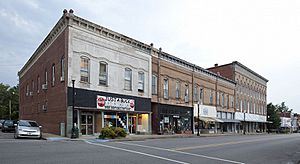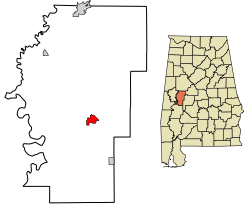Greensboro, Alabama facts for kids
Quick facts for kids
Greensboro
|
||
|---|---|---|

Main Street in Greensboro
|
||
|
||

Location of Greensboro in Hale County, Alabama.
|
||
| Country | United States | |
| State | Alabama | |
| County | Hale | |
| Area | ||
| • Total | 2.39 sq mi (6.18 km2) | |
| • Land | 2.38 sq mi (6.16 km2) | |
| • Water | 0.01 sq mi (0.02 km2) | |
| Elevation | 282 ft (86 m) | |
| Population
(2020)
|
||
| • Total | 2,218 | |
| • Density | 933.11/sq mi (360.25/km2) | |
| Time zone | UTC-6 (Central (CST)) | |
| • Summer (DST) | UTC-5 (CDT) | |
| ZIP code |
36744
|
|
| Area code(s) | 334 | |
| FIPS code | 01-31720 | |
| GNIS feature ID | 0157974 | |
Greensboro is a city located in Hale County, Alabama, in the United States. It is the main town, or county seat, of Hale County. In 2020, about 2,218 people lived there. Greensboro is also part of the larger Tuscaloosa Metropolitan Area.
Contents
History of Greensboro
Greensboro became an official town in December 1823. It was first called "Greensborough." The town was named after Nathanael Greene, a famous general from the American Revolutionary War. Soon after, its name was shortened to "Greensboro." Before it became a town, the area was known as "Troy."
Early History and Plantations
Many places in and around Greensboro show its history from before the American Civil War. Back then, the area was known for its large cotton farms called plantations. Several historic sites are listed on the National Register of Historic Places. These include Glencairn, the Greensboro Historic District, Magnolia Grove, the McGehee-Stringfellow House, Millwood, and the Payne House.
Civil Rights Era
Many years later, African Americans in Greensboro worked hard to gain equal rights during the Civil Rights Movement. They had faced unfair treatment for a long time.
Rev. Martin Luther King Jr., a key leader of the Southern Christian Leadership Conference, visited Greensboro. In 1968, after giving a speech, he needed a safe place to hide from members of the Ku Klux Klan. He found safety in a private home owned by the Burroughs family, who were local activists. This home is now known as the Safe House Black History Museum.
Recent Events
Greensboro has also experienced natural disasters. On May 27, 1973, a strong tornado hit the city, causing a lot of damage. More recently, on January 12, 2023, another tornado caused damage to the southern part of the city.
Geography and Climate
Greensboro is located a bit southeast of the center of Hale County. Several main roads, like Alabama State Routes 14, 25, and 69, pass through the city. These roads connect Greensboro to other nearby towns like Eutaw, Marion, and Tuscaloosa.
The U.S. Census Bureau says that Greensboro covers about 2.39 square miles (6.18 square kilometers). Most of this area is land, with a very small part being water.
Greensboro's Climate
Greensboro has a climate with hot, humid summers and mild to cool winters. This type of weather is called a humid subtropical climate. On climate maps, it's often shown as "Cfa."
| Climate data for Greensboro, Alabama, 1991–2020 normals, extremes 1890–present | |||||||||||||
|---|---|---|---|---|---|---|---|---|---|---|---|---|---|
| Month | Jan | Feb | Mar | Apr | May | Jun | Jul | Aug | Sep | Oct | Nov | Dec | Year |
| Record high °F (°C) | 83 (28) |
87 (31) |
91 (33) |
95 (35) |
98 (37) |
105 (41) |
107 (42) |
107 (42) |
106 (41) |
100 (38) |
90 (32) |
82 (28) |
107 (42) |
| Mean maximum °F (°C) | 73.1 (22.8) |
77.0 (25.0) |
83.1 (28.4) |
86.5 (30.3) |
91.9 (33.3) |
95.8 (35.4) |
97.5 (36.4) |
97.9 (36.6) |
95.1 (35.1) |
89.0 (31.7) |
80.4 (26.9) |
74.2 (23.4) |
99.0 (37.2) |
| Mean daily maximum °F (°C) | 56.6 (13.7) |
60.9 (16.1) |
68.0 (20.0) |
74.5 (23.6) |
81.2 (27.3) |
87.3 (30.7) |
89.6 (32.0) |
89.4 (31.9) |
85.1 (29.5) |
76.2 (24.6) |
65.3 (18.5) |
57.8 (14.3) |
74.3 (23.5) |
| Daily mean °F (°C) | 46.4 (8.0) |
50.1 (10.1) |
56.5 (13.6) |
63.3 (17.4) |
71.0 (21.7) |
77.8 (25.4) |
80.6 (27.0) |
80.2 (26.8) |
75.3 (24.1) |
65.2 (18.4) |
54.4 (12.4) |
48.1 (8.9) |
64.1 (17.8) |
| Mean daily minimum °F (°C) | 36.1 (2.3) |
39.4 (4.1) |
45.0 (7.2) |
52.0 (11.1) |
60.7 (15.9) |
68.4 (20.2) |
71.6 (22.0) |
71.0 (21.7) |
65.4 (18.6) |
54.1 (12.3) |
43.4 (6.3) |
38.4 (3.6) |
53.8 (12.1) |
| Mean minimum °F (°C) | 18.3 (−7.6) |
23.0 (−5.0) |
27.8 (−2.3) |
35.8 (2.1) |
46.6 (8.1) |
58.9 (14.9) |
65.5 (18.6) |
64.4 (18.0) |
51.9 (11.1) |
37.4 (3.0) |
27.4 (−2.6) |
22.8 (−5.1) |
15.8 (−9.0) |
| Record low °F (°C) | −2 (−19) |
−5 (−21) |
10 (−12) |
28 (−2) |
37 (3) |
41 (5) |
56 (13) |
55 (13) |
39 (4) |
27 (−3) |
12 (−11) |
2 (−17) |
−5 (−21) |
| Average precipitation inches (mm) | 5.11 (130) |
5.63 (143) |
5.32 (135) |
5.32 (135) |
4.60 (117) |
3.89 (99) |
4.38 (111) |
3.99 (101) |
3.65 (93) |
3.34 (85) |
4.57 (116) |
5.07 (129) |
54.87 (1,394) |
| Average snowfall inches (cm) | 0.2 (0.51) |
0.0 (0.0) |
0.0 (0.0) |
0.0 (0.0) |
0.0 (0.0) |
0.0 (0.0) |
0.0 (0.0) |
0.0 (0.0) |
0.0 (0.0) |
0.0 (0.0) |
0.0 (0.0) |
0.0 (0.0) |
0.2 (0.51) |
| Average precipitation days (≥ 0.01 in) | 8.5 | 8.4 | 8.8 | 7.2 | 7.2 | 7.6 | 10.0 | 8.5 | 5.5 | 5.5 | 6.9 | 8.0 | 92.1 |
| Average snowy days (≥ 0.1 in) | 0.1 | 0.0 | 0.0 | 0.0 | 0.0 | 0.0 | 0.0 | 0.0 | 0.0 | 0.0 | 0.0 | 0.0 | 0.1 |
| Source 1: NOAA | |||||||||||||
| Source 2: National Weather Service | |||||||||||||
Population and People
| Historical population | |||
|---|---|---|---|
| Census | Pop. | %± | |
| 1850 | 2,500 | — | |
| 1870 | 1,760 | — | |
| 1880 | 1,833 | 4.1% | |
| 1890 | 1,759 | −4.0% | |
| 1900 | 2,416 | 37.4% | |
| 1910 | 2,048 | −15.2% | |
| 1920 | 1,809 | −11.7% | |
| 1930 | 1,795 | −0.8% | |
| 1940 | 2,034 | 13.3% | |
| 1950 | 2,217 | 9.0% | |
| 1960 | 3,081 | 39.0% | |
| 1970 | 3,371 | 9.4% | |
| 1980 | 3,248 | −3.6% | |
| 1990 | 3,047 | −6.2% | |
| 2000 | 2,731 | −10.4% | |
| 2010 | 2,497 | −8.6% | |
| 2020 | 2,218 | −11.2% | |
| U.S. Decennial Census 2013 Estimate |
|||
Greensboro's population has changed over the years. In 2010, there were 2,497 people living in the city. By 2020, the population was 2,218.
Who Lives in Greensboro?
Based on the 2010 census, about 66.5% of the people in Greensboro were Black or African American. Around 32.0% were White. A small number of people were Native American or from two or more races. About 0.5% of the population was Hispanic or Latino.
There were 1,045 households in the city. About 25.6% of these households had children under 18 living there. The average household had 2.31 people.
| Race | Num. | Perc. |
|---|---|---|
| White (non-Hispanic) | 646 | 29.13% |
| Black or African American (non-Hispanic) | 1,503 | 67.76% |
| Native American | 5 | 0.23% |
| Asian | 7 | 0.32% |
| Pacific Islander | 2 | 0.09% |
| Other/Mixed | 40 | 1.8% |
| Hispanic or Latino | 15 | 0.68% |
As of the 2020 United States census, there were 2,218 people, 1,214 households, and 648 families living in the city.
Notable People from Greensboro
Many interesting people have come from Greensboro, Alabama. Here are a few:
- Anthony Bryant – A defensive player in the NFL (National Football League).
- Scott Burton – A talented sculptor and performance artist.
- Theresa Burroughs – A civil rights activist who started the Safe House Black History Museum in Greensboro.
- John Gayle – He served as the seventh governor of Alabama from 1831 to 1835.
- Amelia Gayle Gorgas – A former librarian at the University of Alabama. Her son, William C. Gorgas, became a famous Surgeon General.
- Richmond Pearson Hobson – A member of the United States House of Representatives and a recipient of the Medal of Honor.
- Grady Jackson – A professional football player.
- Pete Jarman – He was a member of the United States House of Representatives and a former United States Ambassador to Australia.
- Herb Jones – A current basketball player for the New Orleans Pelicans. He used to play for the Alabama Crimson Tide.
- Andrew Killgore – A United States Foreign Service Officer and ambassador to Qatar.
- Thomas E. Knight – He was the 13th Lieutenant Governor and 19th Attorney General of Alabama.
- Hedgemon Lewis – A boxer who was a world title contender.
- William Burns Paterson – A teacher who founded Tullibody Academy and Alabama State University.
- Israel Pickens – He was the third governor of Alabama from 1821 to 1825.
- Eugene Sawyer – He served as the 53rd mayor of Chicago.
- Thomas Seay – He was the 27th governor of Alabama from 1886 to 1890.
- Armistead I. Selden, Jr. – A member of the United States House of Representatives and a former United States Ambassador to New Zealand and other Pacific nations.
- Little Sonny – An electric blues musician and songwriter.
- Barry Wagner – A former wide receiver and linebacker in the Arena Football League.
- Bob Wiggins – An outfielder in the Negro American League.
- Henry Williams – A former defensive back in the NFL.
- Lamanzer Williams – A former defensive end in the NFL.
- Cedric Harris – An educator, innovator, and youth mentor.
Images for kids
-
Magnolia Hall, also known as the McCrary-Otts House.
-
The Safe House Black Historic Museum in Greensboro. Martin Luther King Jr. hid here in 1968.
See also
 In Spanish: Greensboro (Alabama) para niños
In Spanish: Greensboro (Alabama) para niños





